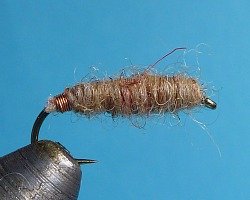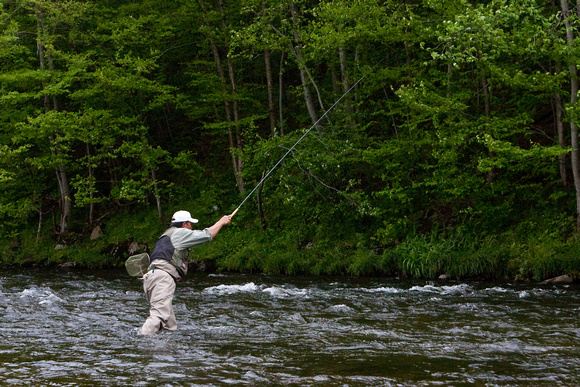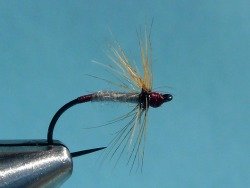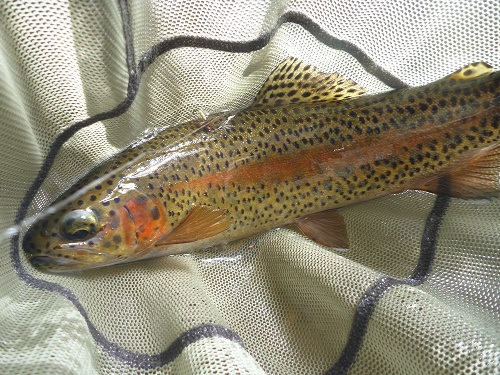Longer Line Tenkara
The Missing Piece, the AHA! Moment, and Boy Do I Feel Stupid
Kudos to Paul Gaskell and John Pearson of DiscoverTenkara.com. In their large body of work,
both written and on video, they have urged that before you try to change
tenkara to suit your own desires, you should thoroughly learn the basics. Of course (or at
least, understandably), that made me bristle a bit. After all, it's just a
rod, a line and a fly - how complicated can it be? Tie the line to the
rod, tie the fly to the line, whip it back and forth a bit to figure out
how to cast, and then go catch fish. Yeah, right.
Kudos should also go to Daniel Galhardo and to Adam Klagsbrun, both of whom have urged essentially the same thing. And of course, kudos to the Tenkara Guides, LLC for hosting the Oni School, which is the only way most Americans will ever learn tenkara basics directly from a Japanese tenkara master.
There is a huge body of knowledge in Japan regarding tenkara. Anything that has been developed over hundreds of years, passing through many, many hands, is the result of countless trials and countless errors.
For some unknown reason, many of us (myself included) insist on conducting our own trials, which almost certainly produce some of the same errors that were originally discovered decades (or centuries) ago, and were weeded out of the current techniques. Some of those errors lead to blind alleys from which it is hard (or very hard) to escape.
You can still catch a lot of fish, but your progress will be limited if you do not take advantage of the knowledge accumulated over hundreds of years.
Long Rod, Short Line

For years and years my "go to" fly was a Killer Bug. Where I often fish it catches a lot of fish. With all due respect to Thoreau, when I go fishing it is the fish that I am after. Plus, I didn't see much point in tying complicated flies when a simple fly worked so well (in my defense, Dr. Ishigaki feels exactly the same).
However, the Killer Bug has a significant disadvantage, which I didn't realize until fairly recently, and which has limited my learning of tenkara. Because it has no hackle, it has very little resistance to being pulled through the water.
Fishing a fly that has little resistance led me to three things: 1) fishing a very light line 2) fishing a relatively short line, and 3) fishing a dead drift.
To a large degree, fishing a light line and fishing a short line are both attempts to keep line off the water's surface. A light line sags less than a heavy line, and a short line sags less than a long line. Both make it easier to keep all your line out of the water, which reduces drag. Reduced drag means better presentations, and better presentations yield more strikes. Keeping the hi-vis line out of the water also greatly reduces the likelihood that the line will scare the fish.
Because a Killer Bug has little resistance, it is difficult to manipulate the fly gently enough to keep your line from bouncing wildly. The line twitch resulting from a trout taking a Killer Bug is usually much, much more subtle than the line bounce you get from trying to pulse a fly that provides almost no resistance. To see the subtle takes, I almost always tried to fish a dead drift.
Fishing a short, light line makes it much easier to achieve a dead drift. I caught a lot of fish and recommended it highly in my Long Rod, Short Line essay.
Long Line Tenkara
Not long after I started TenkaraBum.com I asked Daniel Galhardo of Tenkara USA to write an article on Long Line Tenkara. He routinely used lines longer than I did - occasionally much longer. If you haven't yet read it you are missing out on a style of tenkara that is worth knowing.

In his article, Daniel mentions fishing with Dr. Ishigaki in the
Catskills. I was on that trip, and watched Dr. Ishigaki demonstrate
fishing with a 7 meter line. He was using it to fish eddies and bank
eddies that were downstream from where he was standing.
I have also seen Masami Sakakibara
(Tenkara no Oni) fishing a long line. He, too, was fishing
downstream, using the force of the current pushing against the fly to
keep the line tight and off the surface. Some Japanese tenkara anglers go a step further, and use the current to force the fly to the surface, where they skate it back upstream or side to side.
I’ve never watched many tenkara videos - very rarely can you see the line, and
watching a tenkara video without seeing the line is a lot like reading
printed text without seeing any consonants. You can’t understand what
is
happening.
The few Japanese honryu tenkara videos I have seen, in which you could
tell the angler was using a long line (even though you couldn’t see
it), showed the angler casting down and across, mostly to bank eddies on
the far side. Though the rivers were more rambunctious, the fishing style was very similar to what Dr. Ishigaki demonstrated with his 7m line in the Catskills.
My impression then, based on limited experience, was that lines longer
than the rod were really only used when fishing downstream, using the
current to help keep the line off the surface.
The Missing Piece
Well, this past weekend I learned how wrong I had been. I spent a couple
days fishing with Adam Klagsbrun, who as much as anyone else in
the US is a proponent of learning how tenkara is practiced in
Japan, and also being true to the Japanese definition of what is and
what isn’t tenkara - not so much in how you fish (fish any way you want), but rather in what you call it.
Unfortunately, it seems many (actually many, many) people lost sight of the learning because they got hung up on the
definition.
It took only a few minutes for Adam to describe what I should do to fish a
longer line, and a few minutes more to explain why my tippet should be longer
as well. In the past, I did try to fish a 15 foot line plus 4
feet of tippet with a 12 rod. I found it
impossible to hold the end of the line off the water’s surface for more
than a couple seconds.
I learned from Adam that there were a few flaws in what I was doing. The must serious flaw was that I had attempted to fish a dead drift with a Killer Bug. The missing piece was the hackle.
 A "Futsu" kebari (perpendicular hackle) that Adam used in Colorado.
A "Futsu" kebari (perpendicular hackle) that Adam used in Colorado.In a few recent essays I have commented on how the hackle of a tenkara fly resists being pulled through the water. I should have been using a hackled fly and should have been utilized that resistance while gently manipulating the fly.
Softly pulsing the fly would alternately tighten and loosen the line. The pulsing should be soft enough that the line doesn’t bounce around, and the loosening (between pulses) should be slight enough that the end of the line remains above the surface.
It turns out that keeping the end of the line above the surface is
a bit harder to do if the tippet is only a little over 3' long.
With a 5 or even 6 foot tippet, it is easier to keep the end of the
colored line above the surface. The longer tippet produces another
significant benefit: it produces more, and more gradual, line sag.
Through my writings, I have probably given the impression that line sag is an
evil to be avoided at all costs. I should have made clear that line sag
increases drag (a movement of your fly relative to the water surrounding it caused by water pushing or pulling the line, or by wind pushing the line), but that movement is evil only if you are trying to achieve a
dead drift. Actively manipulating the fly essentially overcomes or masks the drag with intentional movement of the fly. Your fly does move relative to the water around it, and the movement is not what you would call natural, but it can attract the fish and make your fly appear to be alive.
The line sag produces two benefits: it acts as an incredibly sensitive strike indicator (when the line goes straight it is probably a fish); also, the sag introduces enough slack between the rod tip and fly that a fish can take the fly without feeling immediate tension on the line.
I am convinced that fish react more quickly to tension on the line than to the hard hook. On Saturday, my reaction was not lightning fast but I didn't miss even one hit. I saw the take and tightened the line, and in each case the fish had not spit out the hook between the take and the tighten.
The AHA! Moment
In the past I have written about how I see the tenkara rod, line and fly as a system rather than three unrelated items. The long rod, the light line and the fly that resists being pulled through the water all act together to help you keep your line off the surface reducing drag and keeping your hi-vis line from scaring the fish).
The AHA! moment was realizing that pulsing the fly allows you to keep a longer line off the surface when fishing upstream or up and across. I knew that the force of the current against the fly would keep the line off the surface when fishing across and down (which I rarely did), but before fishing with Adam I had thought the longer line was not useful when fishing upstream.
The weight of
the tenkara line will cause it to sag, and that will pull the fly through
the water. Pulling back on the rod to tighten the line and keep it off the surface will pull the fly even more. The fly moving in a different direction and/or at a different speed than the water around it is obvious to a fish, even though it has a brain the size of a pea. Just like drag, a steady movement caused by a sagging line is unnatural.
Pulsing the fly gently, though, allows you to tighten the line in steps. The fly still gets pulled
through the water in a way that isn't exactly natural, but it moves in a way that
attracts rather than scares the fish. The goal is to entice the fish to strike something that looks alive. I suppose that is why the technique is called "sasoi" in Japanese, which means "invitation."
Fishing upstream with a longer line seemed cumbersome when I'd tried it before because as I raised the rod to take up line drifting down towards me, the rod got too high to strike effectively long before the line got down to where I was standing. The solution, of course, is simple. Fish shorter drifts. I have often written that shorter drifts are better (shorter drifts yield more pick ups for a new cast, meaning more "Leisenring Lifts", which are definite triggers for feeding fish).
However, I think I had rejected the idea of long lines fished upstream years before I realized that shorter drifts were in fact better. I'd probably fished only two drifts on Saturday before Adam told me I needed to pick up sooner. Three pulses, maybe four depending on current speed, then pick up for a new cast.
A new tenkara angler's first thought is often "Wow, with the long rod I can get really long drifts." Well, you can, but you can get a lot more strikes if you fish short drifts.

Unfortunately, the weekend was windy enough that I was able to try the
longer line tenkara for only a pretty brief period. During that time I was
able to catch several fish, though. It's a little funny that generations of western wet-fly fishermen have felt that fishing the "upstream wet" was incredibly difficult because they couldn't detect strikes, but after learning how to keep the line tight with very modest, rhythmic pulses and frequent casts, all but one of the strikes I had that day were as obvious as fish hitting a dry fly. I didn't miss one strike!
When pulsing an unweighted
fly, even
quite gently, the fly stays only a few inches below the surface.
Fish coming from the depths to hit a moving fly that was just below the surface
caused enough surface disturbance that I saw the take itself, not
just a twitch or tightening of the line. A fly that is not moving relative to the water around it isn't "getting away" so a trout can be very leisurely in it's take. If the fly is moving, and potentially getting away, the trout take it much more aggressively, causing the surface disturbance or a noticeable flash as they turn to go back down.
The one strike I didn't see came while I had gotten distracted momentarily and had stopped the pulsing, letting the fly sink a bit deeper. When I looked back, the line was tighter than it should have been, so I tightened further to set the hook.
Even though the wind allowed tenkara fishing for only a short time, it took only until catching the first fish to realize that fishing upstream with a line longer than the rod and tippet longer than I'd ever used could be very productive without being very difficult.
Boy, Do I Feel Stupid
Why do I feel stupid? Because over the last 10 years, more than a few people have commented that a Killer Bug isn't a tenkara fly. More than a few people have advocated fishing with a longer line. More than a few people have advocated manipulating the fly.
I have caught lots of fish with a Killer Bug, but using a Killer Bug much of the time led me down a blind alley where I could neither see nor appreciate the benefits of the longer line or the fly manipulation.
I am sure that in the future I will not always fish a hackled fly and I will not always fish a line longer than the rod and I will not always manipulate the fly - just as I will not always fish for trout and I will not always fish in mountain streams. However, I am a lot more aware and a lot more appreciative of the way that the various aspects of tenkara fishing all fit together.
Although Adam had schooled me once before with fly manipulation, this time I think it will stick. I had seen the tenkara "system" as consistsing of rod, line and fly working together. I now see it as rod, line, fly, and fly manipulation working together. Actually, it's more than that. Thinking of Rob Worthing's writings and videos on tenkara casting, it is clear that the casting is part of the system as well - it's not just the tools, it's also how you use them.
I should point out that the line I fished with, while longer than I've ever used (with few exceptions), was not really a long line. The fishing was clearly within the realm of keiryu tenkara (mountain stream tenkara) rather than honryu tenkara (main flow or main river tenkara). I was using a 3.6 meter rod with a bit under 5m of line. Honryu tenkara anglers will use 4 to 4.5m rods with lines of 7m or even longer.
When "tenkara" fishing in rivers, I have often used keiryu rods as long as 6.3m, with a line shorter than the rod, following my "long rod, short line" approach to getting excellent drag-free drifts, often using a fly without hackle. Now that I have had my AHA! moment, I think in the future I will use tenkara rods, lines longer than the rod, hackled flies and fly manipulation rather than dead drifts.
TenkaraBum Home > Tenkara Techniques > Longer Line Tenkara
“The bitterness of poor quality remains long after the sweetness of low price is forgotten” - Benjamin Franklin
"Be sure in casting, that your fly fall first into the water, for if the line fall first, it scares or frightens the fish..." -
Col. Robert Venables 1662
As age slows my pace, I will become more like the heron.
We've all had situations where seriously chewed up flies kept catching fish after fish after fish. It is no sin to tie flies that come off the vise looking seriously chewed up.
Warning:
The hooks are sharp.
The coffee's hot.
The fish are slippery when wet.
Beware of the Dogma
Seriously, all the hooks sold on TenkaraBum.com, whether packaged as loose hooks or incorporated into flies, are sharp - or as Daiichi says on their hook packages, Dangerously Sharp. Some have barbs, which make removal from skin, eyes or clothing difficult. Wear eye protection. Wear a broad-brimmed hat. If you fish with or around children, bend down all hook barbs and make sure the children wear eye protection and broad-brimmed hats. Be aware of your back cast so no one gets hooked.
Also, all the rods sold on TenkaraBum.com will conduct electricity. Do not, under any circumstances, fish during a thunder storm. Consider any fishing rod to be a lightning rod! Fishing rods can and do get hit by lightning!
What's in stock?
Kurenai II AR 30F
Kurenai II AR 33F
Kurenai II AR 39F
TenkaraBum 33
TenkaraBum 36
TenkaraBum 40
Nissin Oni Tenkara Line
Coming Soon
Expected January 13
Furaibo TF39
Furaibo TF39TA
Latest Pages
If you enjoy spin fishing or baitcasting please visit my sister site Finesse-Fishing.com.


